|
|
Posted By Admin,
Monday, June 19, 2023
|
By Web Editor
October 16, 2013
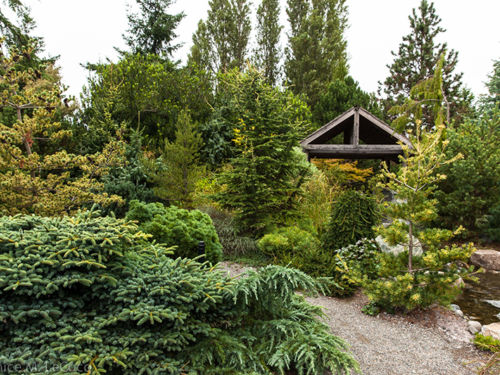
We've written about both large, grand public botanical gardens and small, private, intimate collections. In Southwest Seattle, open to all visitors with no fee, is the newest American Conifer Society Reference Garden: the arboretum at South Seattle Community College, a public space designed and crafted with a personal touch. This arboretum puts many large-university offerings to shame, particularly its Coenosium Rock Garden, specializing in gorgeous dwarf conifers, such as the Picea abies 'Gold Drift' gracing the entry stone.
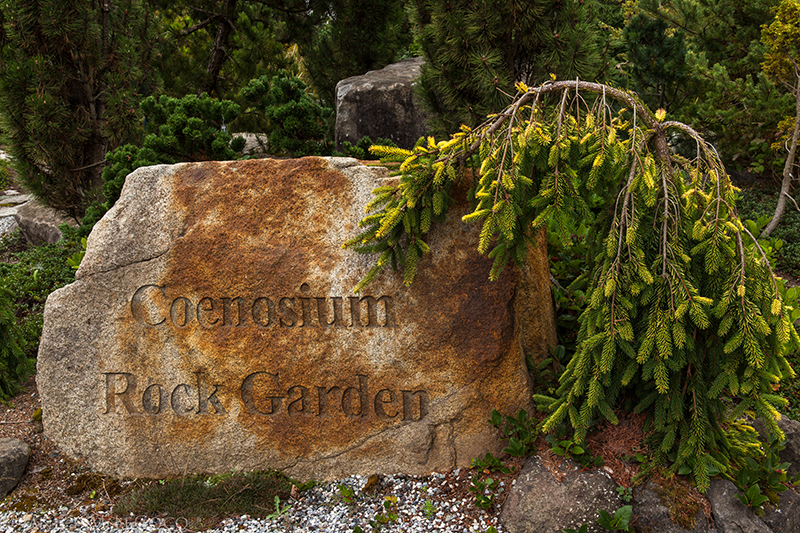
The arboretum was established in 1978 at the north end of the campus, after students in the landscape horticultural program petitioned for an outdoor laboratory. The present-day garden is about five acres and has a sweeping view of downtown Seattle. Although the arboretum counts its Helen Sutton Rose Garden as one of its highlights and there are robust examples of perennial borders, rhododendron and ornamental grasses, it is the two conifer gardens that drew our interest for their excellent displays of form and foliage.
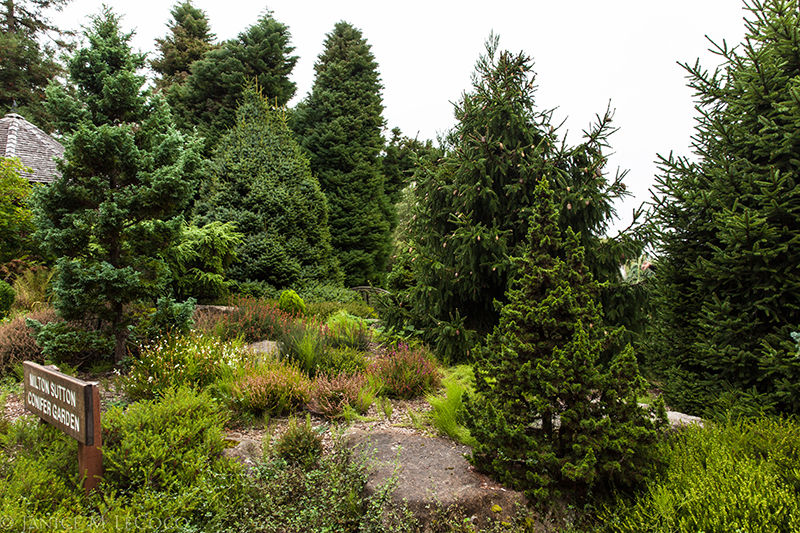
The Milton Sutton Conifer Garden, planted soon after the arboretum was begun, has lovely specimens (and the best view of Seattle!) but is of more interest to the conifer-addict than a gardener seeking ideas about plant combinations, as it does not feature the attention to plant placement and design that characterize the newer Coenosium conifer collection.

Amongst the conifers in this part of the arboretum, though, we found plenty of color and textural variety. The Japanese 'cedar' (not a true cedar, but that's its common name), replete with cones, on the left in the above photo, has distinctly different needles than the blue Atlas cedar on the right. Their colors, too, contrast pleasingly and their shapes are wildly different--the Cryptomeria stands about 40-50' tall while the Atlas cedar drapes itself horizontally in numerous directions.
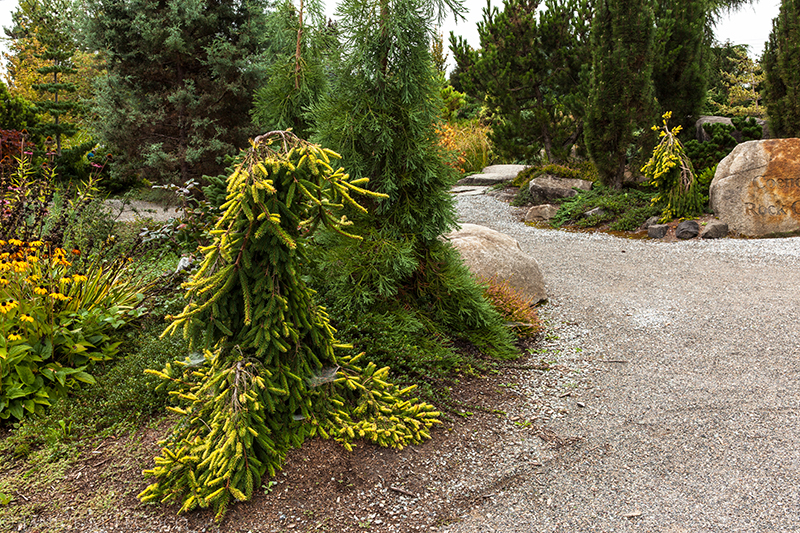
The Coenosium Rock Garden was the brainchild and donation of Bob and Dianne Fincham of Coenosium Gardens, which we wrote about last year. Intended as a teaching tool and laboratory, it also functions as an attractive display garden, with careful attention paid to combinations of color, texture, shape and size. There are non-cone bearing plants sharing the space, from stately European beeches to humble black-eyed Susans, giving those looking for ideas much to see and inspire them.

The Rock Garden was begun in 2000, dedicated in 2005 and inducted into the Gardens for Peace Program in 2010. The site is problematic; much of the soil is heavy and drains poorly. The West end of the garden, which was planted as part of Phase I in 2000, required roughly 60 yard of fill before the 60 conifers and European beeches (which today are over 20' tall) could be planted to make a screen along busy 16th Avenue SW. Most of us don't use material in such large quantities but the principles are the same: poor soil can be amended and woody plants can be used functionally to create and delineate spaces.
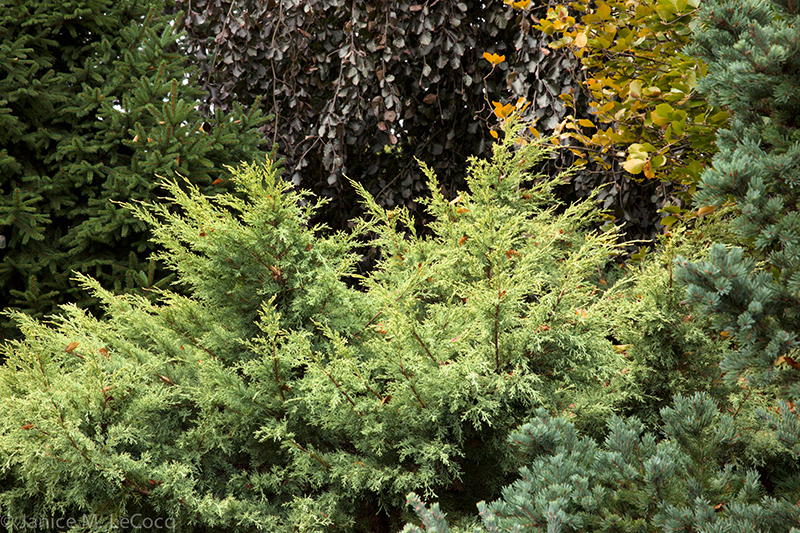
Most of the non-coniferous plantings are European beeches and Japanese maples; both are long-lived, slow-growing trees with lovely shapes, bark, stature and leaf color and texture. The glossy leaves of the beeches and the lacy maple foliage provide a pleasing contrast to the conifer needles, although this garden's designers have taken pains to illustrate that all conifers are not alike.

We lingered in this garden for a couple of hours, partly because there was much to engage the eye, but also because Bob and Dianne envisioned this spot as more than just a laboratory, but also as a richer sensory experience, like most successful gardens. The garden includes a magnificent water feature, donated by the Arboretum Support Committee and designed and installed by SSCC students. The pleasant sound of the water and textural richness of the stone creek bring sound and earthiness into the impressive collection of plantings.
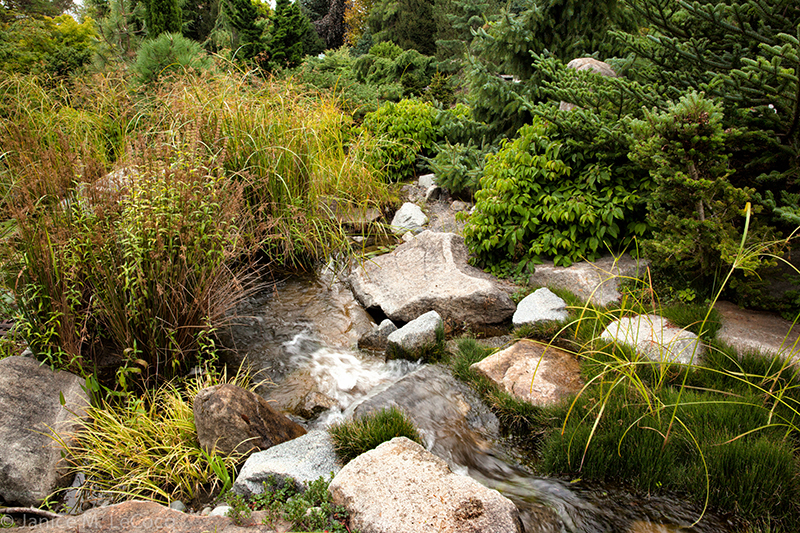
And, like all good gardens, there are benches where visitors can sit and take it all in.
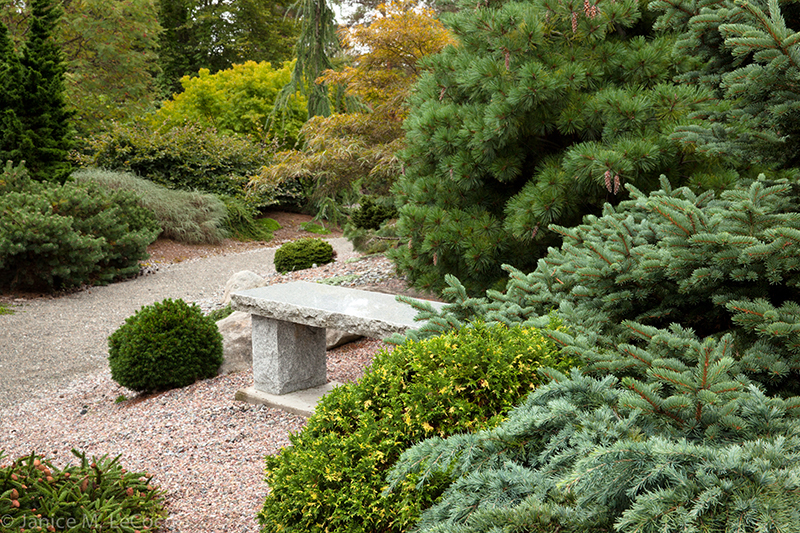
Horticulture Instructor Van Bobbitt is the Arboretum Coordinator, and his students, in addition to using it as a living laboratory, maintain it for the pleasure of others. If you are in Seattle, don't miss this lovely spot: South Seattle Community College Arboretum. Follow the Arboretum on Facebook.
This post has not been tagged.
Permalink
|
|
|
Posted By Admin,
Monday, June 19, 2023
|
By Web Editor
October 2, 2021

Conifers and maples are a lovely combination in climates where both thrive
Bruce Feller and his wife Marianne have a two acre garden on Long Island, replete with not just conifers, but maples and rhododendron as well. Both Bruce and Marianne are long-time members of the American Rhododendron Society and Bruce was the national president in 2013-2014. Their son, Colby, has served as President of the ACS Northeast Region. The Fellers have graciously opened their garden daily to visitors; for specifics, go to the end of this article.

Maples ablaze with fall color in the Feller garden
The Fellers' garden gets more coverage from the Rhododendron aficionados than from the coneheads or maple lovers, but in autumn the maples grab the limelight and it is the conifers that play off the fiery colors.

Red and green are color wheel opposites, which produce dramatic contrast
Color wheel opposites, such as red/green or orange/blue, produce the most dramatic combinations. Fall color is pretty dramatic by itself, but it is enhanced with the addition of conifers to the deciduous fireworks. The blues and greens of the conifers play against the hot autumn hues.
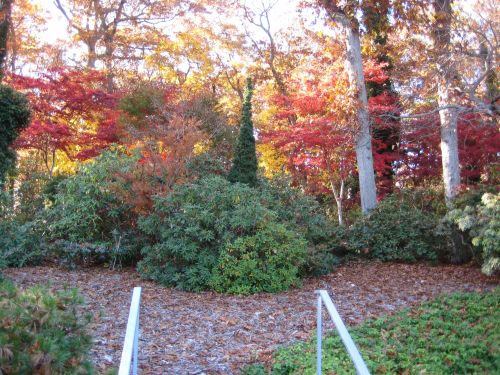
The maples are especially incendiary when backlit
In the above photo, the rhododendron do yeoman work as foils for the maples. Like members of the chorus supporting the starring cast, they frame the drama and enhance it.
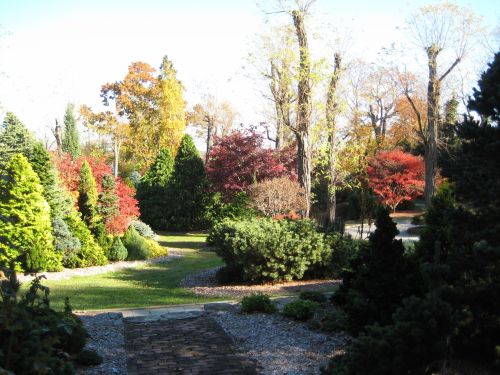
A late afternoon shot of the garden bathed in the soft light of autumn
The conifers also provide some relief from the high drama and allow the eye to rest a bit. The green is cool and soothing and adds a note of lushness.
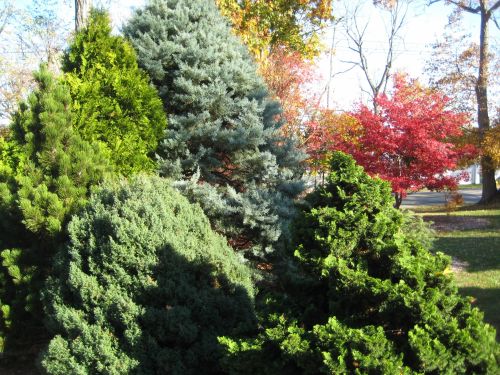
In this shot the conifers display a wide range of hues and textures
Conifers come in almost every shade of green, as well as blues, yellows, golds, and variegated foliage. In this shot we see five conifers, each of which has its own color and texture, creating a rich tapestry effect. Lest we forget who's in charge in autumn, a blazing maple looks over their shoulders.
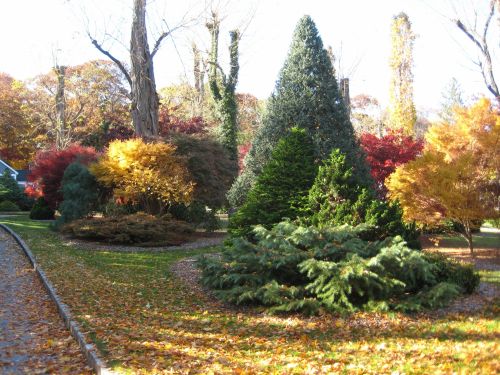
A softer combination of colors with yellow maples instead of red
The green and blue shades of the conifers play equally well against yellow fall foliage, creating a softer display. As an added bonus, they don't produce leaf drop that needs to be raked!
Thanks to the Fellers for allowing us to peek into their garden. If this has whet your appetite for more, the garden is open daily from 10 am to 6 pm. The garden, in Oldfield, NY, is a perfect place for a change of scene, a casual stroll, or to get inspired to create the same kinds of captivating combinations that the Fellers have done. You can just drop by (88 Oldfield Road) or call ahead to Bruce at 631-689-9498. Bruce says peak maple color is late October but notes that the conifers always put on a show!
This post has not been tagged.
Permalink
|
|
|
Posted By Admin,
Friday, June 16, 2023
|
Invasive Conifer Pests: The Siberian Silk Moth
By Gerry Donaldson
March 7, 2020
Get to know a common invasive species in conifers: the Siberian silk moth.
An adult male Siberian silk moth (Dendrolimus sibiricus), an invasive conifer pest
In its native range, the Siberian moth is found in the Urals, Siberia, and other areas of the Russian Far East. The larvae feed on needles and occasionally on the bark of branch tips and cones of most conifers in the Pinaceae family, showing a preference for Abies sibirica, Larix spp., and Picea spp.
Adult moths fly from late June until early August and lay eggs on needles or branches, commonly on branch tips.
An adult female Siberian silk moth (Dendrolimus sibiricus), an invasive conifer pest
Siberian Silk Moth Population and Outbreak
The population of Siberian silk moth in its native range can remain at levels tolerated by forest trees for many years, but as populations build, rapid outbreaks can occur. Such outbreaks in coniferous forests frequently result in the death of virtually all trees in the infested forest due to a weakening of the trees through defoliation and/or fire.
The length of the life cycle varies from two to four calendar years depending on population density. The larvae of the males have 5 to 9 instars, those of females 6 to 10; typically males have 5 and females 6. The larvae are up to 110 millimeters (four inches) long.
Moths fly from the end of June to the beginning of August and lay eggs on needles and branches. Commonly two winters are spent in the larval stage; second to third instars and fifth to sixth instars overwinter coiled up, under the forest litter. Pupation occurs from mid-June to late July in cocoons in tree crowns.
A larvae of the Siberian silk moth (Dendrolimus sibiricus), an invasive conifer pest
Extreme Defoliation and Conifer Death
Because of the variability of the number of instars, those years when a large number of larvae emerge, the result is an overwhelming population and extreme defoliation. The resulting death of a high percentage of forest trees can result in widespread fire.
You can help in monitoring for invasive species by being aware of what is happening in your garden. If you see something that looks suspicious, take a photo and then contact a Sentinel Plant Network member garden, your local extension agent, or your state Department of Agriculture for help in identifying the insect or disease. The USDA provides additional information and educational modules and trainings at https://firstdetector.org/.
Eggs of the Siberian silk moth (Dendrolimus sibiricus), an invasive conifer pest
Click here to learn how to control conifer pests, or here to read more about other conifer pests like the parasitic wasp, the hemlock woolly adelgid and the Asian longhorned beetle.
Photographs by BugwoodWiki, and the University of Georgia, and the USDA.
This article was originally published in the Summer 2018 issue of Conifer Quarterly.
This post has not been tagged.
Permalink
|
|
|
Posted By Admin,
Friday, June 16, 2023
|
Bayard Cutting Arboretum wins 2020 ACS Iseli Grant
By Web Editor
November 14, 2020
The future Iseli Award site. Photo by Kevin Wiecks
This article was written by Bayard Cutting Arboretum employees Kevin Wiecks, Joy Arden, Jessica O’Callahan.
Extensive Conifer Collection
Bayard Cutting Arboretum (BCA) is a 691-acre tract in Great River, NY, along the Connetquot River on the south shore of Long Island. The property, constructed in 1886, was originally owned by Mr. William Bayard Cutting and his family. Mr. Cutting saw potential in the natural beauty of the surrounding landscape, and, utilizing plans developed by the noted landscape architecture firm of Frederick Law Olmsted, began the arboretum in 1887.
BCA is home to many unique specimens, extensive collections of oaks, hollies and rhododendrons, and expansive native woodlands. However, the most notable collections are those including conifers. Mr. Cutting began to plant his conifer collection in the late 1800s, with the support of Dr. Charles Sprague Sargent, then Director of Harvard’s Arnold Arboretum in Massachusetts. Mr. Cutting had an affinity for firs and spruces because of their kempt and conical habits, in contrast to what he saw as the unruly appearance of pines. He appreciated rare specimens that could grow both in his backyard and across the world. Some of his original plantings can be seen today in the heart of the Bayard Cutting Arboretum, the Old Pinetum.
Abies pinsapo (Spanish fir). Photo by Kevin Wiecks
History of Bayard Cutting Arboretum
After Mr. Cutting passed away in 1912, his wife, Olivia Cutting, continued his legacy by advancing the development of the arboretum and sourcing trees from nurseries all over the world. Rare and unusual specimens came from notable sources such as the Arnold Arboretum, New York Botanical Garden, Princeton University, the US National Arboretum, and local sources such as Hick’s Nursery in Westbury, NY.
Bayard Cutting Arboretum was gifted to the Long Island State Park Region in 1936 by Olivia Cutting and her daughter, Olivia James, in memory of William Bayard Cutting, “to provide an oasis of beauty and quiet for the pleasure, rest, and refreshment of those who delight in outdoor beauty; and to bring about a greater appreciation and understanding of the value and importance of informal planting” (BCA Mission Statement). Her generosity and foresight have allowed BCA to remain a peaceful escape that has been dedicated to horticulture since its opening in 1954. This would not be possible without the incredible support and dedication of the arboretum’s Board of Trustees and the Olivia Cutting Trust.
The conifer garden at the Manor House at the BCA. Photo by Heather Coste
Bayard Cutting Arboretum has one of the most significant conifer collections in the region. It is not only a place to view mature specimens of diverse taxa, but also a place to experience these trees in a variety of settings, celebrating the natural and informal landscape that was described in the arboretum’s mission. Under the horticultural direction of Nelson Sterner, Executive Director, and Kevin Wiecks, Landscape Curator, the conifer collection currently contains 1,600 specimen conifers, representing 352 taxa.
Native Conifers
Taxodium ascendens ‘Morris’ (Debonair™ pond cypress) was recently planted in an allée along a footbridge near the Woodland Garden. The slender habit of this cultivar lends itself to use along paths, and the delicate foliage contrasts beautifully with that of the straight Taxodium ascendens species. Walking through the rolling landscape of Oak Park, you will eventually find a grove of dawn redwoods (Metasequoia glyptostroboides). This hidden forest was planted from saplings donated by the New York Botanical Garden in 1958. Although there are significant conifers throughout the Arboretum's 691 acres, the most significant specimens can be found in the Old Pinetum, New Pinetum, Pinetum Extension, and the newest addition, the Conifer Garden. These collections differ in plant selection, design, and maintenance.
T
Tsuga canadensis 'Sargentii'. Photo by Kevin Wiecks
Conifers from Joe Cesarini and Ed Rezek
Pseudolarix amabilis. Photo by Bill Wykoff
The Conifer Garden was created in 2016 by Lynden Miller and Ronda Brands, renowned public garden designers. This garden uses a unique selection of conifers sourced from specialty nurseries throughout the country. The winding paths of the Conifer Garden ultimately lead visitors to a very special collection, The Ed Rezek Dwarf Conifer Garden. This garden showcases the dwarf conifers bred by this Long Island native and co-founder of the American Conifer Society. It consists mostly of Chamaecyparis obtusa (Hinoki cypress), for which he was famous. The collection was gifted to the BCA by Ed’s widow, Maureen Rezek. Thirty-eight plants were transplanted from the Rezek’s home in Malvern, NY. Maureen entrusted the BCA with the creation of a garden to memorialize Ed’s legacy.
Ed Rezek Dwarf Conifer Garden. Photo by Kevin Wiecks.
As a historic arboretum, the most significant difference between our conifer collections and many others is age. Letters from our archives show a well-thought-out plan with consultation from the greatest minds in our industry, in order to shape the future of Bayard Cutting. In 1929, Olivia James wrote to Dr. Sargent asking “what size the trees are apt to be when fully grown?” She was referring to small trees that were gifted to BCA from the Arnold Arboretum that had originated from specimens brought back from China by E.H. Wilson. Sargent replied: “As the Chinese conifers have only been in cultivation for a few years, it is impossible even to form an idea of the size they will grow in this country.” (BCA Archive). The staff is still learning and experimenting in the footsteps of their predecessors. The age of the collections is not only noted in the maturity of trees, but in design, the changing environment, and plant selection of newer breeds
As a recipient of the 2020 Jean Iseli Memorial Grant, Bayard Cutting Arboretum is entering the next phase of its horticultural development. The new conifer collection is projected to debut in 2021. It is intended to showcase very slow-growing conifers, in contrast to more mature, species specimens nearby. The new garden will be planted in two adjoining beds in the Old Pinetum, breathing new life into an area that is showing its age.
The entire staff has been involved in this project, but the real architect of this garden is the grove of Chamaecyparis pisifera ‘Plumosa’ that graced the site. Every decision considered these tall, elderly conifers. After much deliberation, the staff removed the smaller 'Plumosa' from the bed to create space for new cultivars. The removal also allows sunlight to reach the interior of the garden and to create a better habitat for sun-loving conifers. They also raised the canopy of the remaining trees to reveal their large, lovely, reddish-barked trunks. This exposed an area with potential for a shaded woodland, as well as additional space for new conifers. A shady woodland and sun-loving conifers? The staff consulted with Ronda Brands for this unique problem: 'How do we thematically connect this aesthetic incongruity?' The Chamaecyparis of course! They are the unifying characters of this entire space.
Chamaecyparis obtusa 'Nana Gracilis'. Photo by Heather Coste
In addition to keeping most of these tall Chamaecyparis trees, the BCA kept a large Abies grandis (grand fir), and a mature Pinus strobus ‘Pendula’ (weeping eastern white pine). They widened the existing beds on either side of the grass pathway, which directs people toward a Tilia × europaea (common linden) and encourages them to walk beyond the Tilia and further explore the Old Pinetum. The slow-growing conifers will be planted on either side of the grass pathway, in the original bed that borders what Ronda has deemed the “Chamaecyparis Cathedral”.
The next step in the garden installation will be mapping the new specimens and adding them to the arboretum's database. Details and locations of the new, slow-growing conifers will be accessible on the arboretum's interactive Tree Explorer. This technology provides visitors and staff a deeper look into the arboretum’s evolving collections.
The arboretum would like to recognize the American Conifer Society, the Iseli Memorial Grant, and Iseli Nursery, as well as the hard work and passion of Jessica O’Callahan, Bayard Cutting Arboretum’s horticultural intern. Visit the BCA website for more information.
This post has not been tagged.
Permalink
|
|
|
Posted By Admin,
Friday, June 16, 2023
|
Exciting New Conifers of Northern Vietnam
By Eric Smith
June 29, 2017
I have had the pleasure of botanizing in many areas of southeast Asia over the past 20 years, but few places have provided such botanical surprises as northern Vietnam. Most people would probably guess that the climate throughout Vietnam is tropical and for the most part, that is correct. However, the steep karst mountains that make up the border between China and Vietnam are home to the tallest mountain in Indochina—Fan Xi Pan—topping out at 10,312 feet (3,143 m) above sea level. Hidden within these mountains, one may find plants ranging from alpine to subtropical, but the area that I am most interested in is the remarkably diverse temperate zone, found somewhere in between.
Our crew, with Five Fingers in the background
In the fall of 2013, I helped plan yet another return trip to a few very interesting spots in Vietnam along the Chinese border with my usual traveling mates—Dan Hinkley (Heronswood Garden), Ozzie Johnson (Atlanta Botanical Garden), and Andrew Bunting (Chicago Botanical Garden). We began our trip by exploring an area called Five Fingers that, except for a few hunting trails, was virtually unexplored, at least by westerners. The botanizing in this area was so enthralling that we really didn’t notice that our “guide” hadn’t the faintest idea where we were or which way to proceed after the first couple of days. We decided to follow the treacherously steep river gorge, imagining that it would lead to civilization, which it eventually did. However, during the course of the day trying to get out, two of our party became dangerously exhausted and dehydrated, which was exacerbated by a snafu with our lighter the day before, leaving us without any way to purify any of the water that surrounded us. Let alone the fact that we hardly had enough food for the planned excursion, this extra time in the woods left us with virtually nothing to eat.
 Adult juvenile foliage Cupressus vietnamensis
It is times like these that truly bring to light the fact that plant exploring isn’t always as “romantic” as it sounds. The first excursion of the trip was becoming less fun and more dangerous by the minute, but we finally made it out the following day and were met by a small army of locals who had formed a search party to come hunting for us. They had food and water, so we sat in the middle of the road and gorged ourselves until we could hardly move.
The limestone hills of Ha Giang province
The next day we all awoke extremely sore and stiff from the Death March we had just endured. Rather than go out on another trek immediately, we decided to get in the jeep and head to the northeast to give our muscles a rest for the day, to look for the exceptionally rare Vietnamese Golden Cypress (Cupressus vietnamensis). We spent the next day and a half bouncing along dirt roads through sweltering lowlands, but we finally arrived at a remote town in Ha Giang province. That evening, we planned our route and, early the next morning, we set off. Since we had decided to take LONG day hikes in this area and stay at the one hotel in town, we could travel light and with a very small group, allowing us to cover a lot of ground in a day. Since we were only at about 6,000 feet (2,000 m) elevation, the temperature was much warmer than it had been on Five Fingers, and the humidity was stifling during the heat of the day. By lunchtime, we had reached an area on the ridge where the forest began to thicken. In an effort to get just a little higher to get a better lay of the land, Dan suggested we climb a small knoll to have lunch. We did just that, and as we began to take our packs off, we noticed, right on top of this little limestone knoll, a scraggly but surviving Cupressus — the only one we would find on this trip. Not only is this tree a relatively new species, it is also in peril since there are only 560 individuals known to exist on just 10 square kilometers of habitat. This indicates that the genetic diversity is quite low, which does not bode well for the long term survivability of the species. Interestingly, we found the cypress growing with Mahonia, Aucuba, and several species of terrestrial and epiphytic orchids. We spotted the main goal of our trip fairly quickly, but none of us were ready to make the long return journey just yet, so we carried on in that area for several days and eventually found an equally rare species called Amentotaxus hatuyensis. This tree has great potential for introduction, but conservation measures must first be put in place as there are only 250 mature individuals known to still exist. The resinous, long lasting timber makes both Amentotaxus and Cupressus vietnamensis a favorite for building materials, but soon there will be none left, if the current rate of destruction continues.
 Amentotaxus hatuyenensis
Now, several years later, I have just returned from my 6th trip to Vietnam this past April. We are now working with a team from the University of British Columbia and the Vietnam Academy of Science in an effort to formalize the conservation of a few of these highly diverse areas that are under siege. With some luck, the next couple of years will see positive changes in the habitats that surround these sensitive areas.
Text and Photos by Scott McMahan, Manager of International Plant Exploration, The Atlanta Botanical Garden
Excerpt from the June 2017 Southeastern Conifer Quarterly.
This post has not been tagged.
Permalink
|
|
|
Posted By Admin,
Friday, June 16, 2023
|
Collectors' Conifer of the Year - orders now closed
By Kathryn Keeler
December 9, 2022
We are so happy to announce that in the 18th year of the CCOY program, we are back in business after its 2022 hiatus. Last year due to the impact of unprecedented weather conditions, insufficient inventory was available at the time to fulfill CCOY needs. Looking back even further, CCOY temptations were first available as a member benefit in 2006 with the intent of adding enjoyment and excitement to members’ landscapes. Besides providing for great opportunity to enrich the therapeutic and creative side of gardening, another important aspect of the program is that sales support the Society’s efforts to promote conifer utilization and appreciation.
If you'd like to place an order today, you can order HERE now. Thank you for your continued participation!
For CCOY 2023, we have one species of dwarf, colorful, interestingly textured, false cypress and two larger growing, pines. One pine has a narrow, upright, irregular structure and the other is fuller and more pyramidal that transforms to a brilliant beacon of yellow in the winter. And for a historical note and opportunity, two CCOY honorees from 2018 and 2020 are available this time for anyone that has missed acquiring them or just needs to have another to make a special addition to their garden.
So may your conifer passion be assuaged with the following garden gems that offer varied colors, textures, hardiness, and diversity of form. Life is short, indulge and savor!
CCOY 2023
Chamaecyparis obtusa ‘Gitte’: This eye catching, dwarf, mound forming, golden colored Hinoki cypress was found by Peet Schrauwen of Boomkwekerig Schrauwen-Moering Nursery, Sprundel, The Netherlands as a sport on ‘Tsatsumi Gold’. It stands out from other Hinoki selections by having a dense tangle of twisted, filamentous branches that emanate in varied directions. It is also known for occasionally producing fascinated growth on the tip of its coarsely textured branches. Growth can be from 1 to 6 inches per year, depending on the site’s conduciveness to plant vigor. A sunny well drained site will result in the best coloration and performance. As typical with most yellow selections, a shadier site will cause the plant to become much greener. In ten years, it can be expected to have a remarkable specimen that is 1 to 5 feet high by 2 to 6 feet in diameter. Our offering is propagated on its own roots from a cutting. It is considered suitable for USDA zones 5 through 8.
Pinus banksiana ‘Jack’s Bean Stalk’: This is a choice, unusual Jack pine that has a clever name. It was found by Mike and Cheryl Davison who enjoy hiking and botanizing in the upper Great Lakes and in the Cascade mountains. It stands out from other Jack pine selections because it has such an incredible narrow, upright form with an irregular branching habit. Because of such branching, no two plants will conform to each other. Rather, they will assume their own unique, constantly evolving sculpture like form. Adding to their natural, artsy beauty are interesting, stiff, short, slightly curved, medium green needles that are held in bundles of two. Needles are shed after two to three years so its relatively less dense canopy allows the bones of the sculpture to readily be revealed. The combined effects of these characteristics make for quite a standout in the garden without it needing much horizontal space. In ten years, a specimen could be 4 to 10 ft. tall and 2 to 3 ft. wide. Jack pine is suitable for USDA zones 2 through 6. Our offering is grafted onto Pinus sylvestris (Scots pine) rootstock which is adaptable to a variety of well drained soils. This bean stalk needs a sunny site.
Pinus contorta var. latifolia ‘Chief Joseph’: This selection of lodgepole pine is often the envy of a conifer connoisseur and many people have found it a challenge to achieve a long term, handsome specimen. A well-drained, sunny site protected from buffeting winds in the winter, along with geographic areas that are not burdened with long durations of high heat and humidity are primary criteria for having success with this winter wonder. In summer it appears as an unassuming green, but decent looking pine. As seasonal, colder temperatures arrive, it starts to transition to a bright yellow. As cold weather becomes consistent, this conifer assumes an astonishingly rich and saturated golden glow that totally takes over the landscape as a focal point. It was found in the Wallowa mountains in Oregon by Doug Will during a hunting trip. It was named after a leader of the Wallowa tribe of the Nez Perce. It grows 4 to 8 inches a year. In ten years, this pyramidal, winter dazzler could be 5 to 6 tall and half as wide. Our offering is grafted onto Pinus sylvestris (Scots pine) rootstock which is adaptive to a multitude of well drained soils. ‘Chief Joseph’ is suitable for USDA zones 5 through 8.
Abies concolor 'Archer's Dwarf': This versatile, dependable, low-maintenance selection of white fir is back on the order form. Its compact, pyramidal form is striking, with branchlets that hang slightly downward and inward on tiered, horizontal branches. The powdery blue, blunt, flat, sickle-shaped needles are prominently held in curved upright positions for a most captivating texture. Yearly growth is typically three to four inches. A specimen is generally three feet high and two and a half feet wide in ten years. J. W. Archer of Farnham, United Kingdom, originated this cultivar, which was introduced to the nursery trade in 1982. Our offering is grafted onto Abies bornmuelleriana (Turkish fir) rootstock, which is more adaptive to varying soil conditions and more heat tolerant than other choices. It does best in a sunny site but also performs well in light shade. It is suitable for USDA zones 3 through 7, although some gardeners reportedly have succeeded in zone 9.
Cedrus Atlantica 'Sapphire Nymph': This gorgeous, prostrate, dwarf selection of blue Atlas cedar is also back on the order form. Its origin is accredited to Pat McCracken of McCracken Nursery in Wake County close to Zebulon North Carolina. It first appeared as a witch’s broom and was introduced in the late 1990s. Growth is typically one to three inches per year. The plant will likely be 10 inches high and 30 inches wide in ten years. Its irregular flattened form responds well to pruning, if desired, to refine its shape or contain it for a particular space. Be aware that it is considered somewhat of a more delicate plant as its internodes lack the normal elastic strength of the species. Consequently, it is wise not to site it close to high-impact activities where it can risk injury. In general, this should not be a concern for tranquil garden settings, especially considering what the plant can offer in landscape value. Full sun promotes optimum vigor, and well-drained, acidic to slightly alkaline soil is essential. Once established, it is tolerant of drought. ‘Sapphire Nymph’ is considered reliably suitable for USDA zones 6 through 8. Some success has been reported in zone 9. At its most northerly limit, it is advisable to offer some winter protection to prevent potential discoloration of the needles should severe weather arise. The densely packed, small, stiff needles are arranged spirally outward around the stems, with the ones at the tip pointing forward and noticeably smaller. Overall, the plant has an appealing, prickly texture but is not that sharp to the touch. This non-aggressive, low-growing conifer stands out with its silvery, bright, soft blue color and a slightly coarse but pleasing look. Our offering is grafted onto Cedrus deodara (deodar cedar) rootstock.
Ordering: The Collectors’ Conifer of the Year program is restricted to active members of the American Conifer Society. Purchases are limited to one of each selection per member. Prices can be found on the accompanying order form. Each offering comes with a one-year/one-time replacement guarantee should it fail to grow during the first year in its appropriate USDA zone. Accompanying each plant will be an anodized aluminum tag with its holder, which identifies the plant as a winner of the American Conifer Society’s annual “Collectors’ Conifer of the Year” award. We will begin shipping in the Spring of 2023 and the shipping cost is included in the listed prices. For ordering, please complete the form in this publication. Orders will be filled by the date of receipt until inventory sells out. All orders must be received by February 1, 2023. We cannot ship outside the United States.
The best of conifering to all of you!
While online ordering is preferred, checks with this FORM can be mailed to:
American Conifer Society
Attn: Collector's Conifer of the Year
8441 Wayzata Blvd., Suite 270, Golden Valley, MN 55426
Chamaecyparis obtusa ‘Gitte’
Pinus banksiana ‘Jack’s Bean Stalk’
Pinus contorta var. latifolia ‘Chief Joseph’
Abies concolor 'Archer's Dwarf'
Cedrus Atlantica 'Sapphire Nymph'
This post has not been tagged.
Permalink
|
|
|
Posted By Kathy Swanson,
Friday, June 16, 2023
|
More Amazing Conifer Seed Cones!
By Web Editor
May 13, 2018
Spring is the season for gorgeous seed cones, and even male pollen cones can be decorative. Most people think of 'pine' cones as brown and dry, because the cones that fall and are collected are always older seed cones from prior years. But real coneheads know that this year's cones, both male and female, are the real eye candy. ACS member Ellen Smart caught this Pinus contorta really showing off:
Pinus contorta male strobili by Ellen Smart
Just as pretty as those silly flowers that Angiosperms produce, right?
She also found a fabulous seed cone cluster on a Korean fir:
A particularly fecund Abies koreana by Ellen Smart
Even older cones can be decorative, even though sometimes you have to look carefully to find them. On the conifer road trip to the San Bernadino Mountains two weeks ago, Dave Olszyk found an enormous Calocedrus decurrens with a cluster of last year's seed cones. Like so many little birds in a nest with their mouths open:
Calocedrus decurrens, or incense cedar, by Dave Olszyk
It was a really fun trip and cones seemed to be everywhere. We even spotted one in a Starbucks:
Now this is a really committed conehead!
This young Abies concolor 'Blue Cloak' cone doesn't look like much:
White fir young female cone
But look what's inside:
The 'flower' inside the white fir female cone
So get out there and explore your conifers for spring cones!
And if you missed this post, here are 12 more cones for your enjoyment.
This post has not been tagged.
Permalink
|
|
|
Posted By Admin,
Friday, June 16, 2023
|
Planting Conifers in Small Gardens
By Dan Spear
November 3, 2019
Find inspiration for your next small garden project from a suburban conifer hobbyist.
Dan Spear's conifer garden in Orange, California near Los Angeles
This piece is about a small suburban garden, getting inspired by others in the American Conifer Society, and how I was able to increase the amount (and variety) of conifers to fuss over, enjoy and admire.
My property in Orange, California, 50 miles southeast of Los Angeles, is about 1/3 of an acre, but being on a hill with a very strange pie-shaped lot, concrete takes up a fair portion of the space. I was able to acquire more room for conifers the same way many of us suburban hobbyists get more space: take out more grass. This project was in my back yard.
The original owner/builder of my twenty-eight year old house landscaped the backyard into thirds, going uphill from the back of the house. One third concrete patio, one third grass, and one third 4’ high raised planter, totaling about 78’ wide by 45’ back, up the hill. My newest conifer garden laid out to about 78’ by 15’.
Conifers in Small Gardens: Plant Small and Plant Up
Adding another layer of challenge was my lack of soil. I live on a 400’ high hill, about 100’ from the bottom, which has some sort of volcanic origin. I constantly dig up red, gray, and black lava rocks which have been rounded like river rock, but much of my back yard consists of pyroclastic flow (a volcanic rock mixture which flowed down hill as a molten liquid before cooling and hardening) which is completely exposed in some areas, or lying a few inches below the soil.
Because of these conditions, I have established two very strict gardening principles: plant small and plant up. My new conifer garden would be in raised beds to give me another 10”– 12” inches of soil. I had been planning this new garden for several years, but the horror of having to get all of those rocks, soil, gravel for paths, up all of those steps from the front of the house to the backyard prevented me from moving forward.
As I said, I live on a hill, where the front of the house is two stories, but the back is only one story, the top floor. What really inspired me, and gave me the impetus to get started, was visiting two gardens during the ACS’s Western Region meeting in Tacoma, Washington, in September last year. If you have not seen these two gardens, please add them to your bucket list. You will thank me.
A view of the small garden, stonework, and conifers
Small-Spaces Inspiration from the American Conifer Society
Will Fletcher and Dave Olszyk have extreme Addicted Conifer Syndrome, as their incredible gardens reveal. I was absolutely amazed at the number of conifers each of these men had been able to plant in their gardens; all the while keeping their gardens looking uncluttered and fantastic.
They have really taken it to another level, and made me realize I had way more room for conifers in my garden and so, I decided to dip my toe in the water, and plant my new conifer garden in that vein, sort of.
The timing was just right to be so inspired, considering I was in the heart of conifer country and we were bidding on plants at auction, as well as visiting some of the best conifer growers in the world. Additionally, the best time for planting in my area is December and January, so all of the stars were aligning.
Another angle of the suburban conifer garden
A Backyard Makeover for Small Conifer Gardens
I had a handful of anchor trees in this area I had planted several years earlier; a 15’ Araucaria columnaris, two Ginkgo biloba ‘Saratoga’, a peach, an avocado, and a couple of sweet gum trees, which were really ideal for the structure and the shade they provided; which is required to grow many of the conifers I had been dreaming about.
Our hot, dry weather, with pronounced lack of winter chill, really limits the number of species which can grow here, and forget about the recommendation of “Full Sun” on the labels and in the books, with the exception of junipers, cedars, and some cypresses. For the most part, full sun equals dead plant in short order.
I decided to make the raised beds with 12” to 16” granite cobblestones with a centered meandering path of ¼” gravel. In some areas, I was able to go two rocks high for a tiered look. I ignored my ego about doing the back breaking task of carrying all these materials up the steps myself and hired some men to do the heavy lifting, but I did place every rock and was the official compactor of soil, and sand/gravel for the path. It was still a ton of work, and one of the three hired hands only made it for day one, never to be seen again.
My little backyard makeover ended up taking 12,000 lbs. of rock, 9 yards of soil, and 5 yards of sand and gravel. Quite an effort just to get started.
Dan's conifers, Golden Leyland Cypress (Cupressus x leylandii ‘Gold Rider’) and Kashmir Cypress (Cupressus cashmeriana)
Finding Conifers for a Small Garden
These poor, but well-paid guys crawled away barely alive; so now it was time for the fun stuff; planting about 130 of the most beautiful conifers I had recently purchased. Laying them out to get the best combinations of color, texture, size, form, and architecture, all the while considering sun exposure, was a challenge, but incredibly fun too.
Fir are one of my favorite plants, but also very challenging to grow in our hot, dry climate. Given this new garden had more shade than in other areas of my yard, I decided to give it a go (yet again) with Abies koreana, A. nordmanniana, A. numidica, A. cephalonica, a number of Chamaecyparis obtusa, as well as Cryptomeria japonica, all of which don’t do well with sun here.
I also found two darling dwarf seedlings of Abies concolor var. lowiana in our local mountains over the summer,
and was able to bring them home in January while they were dormant. They’re fairly blue, with needles about one third the length of the standard Low fir. They also love shade in their natural environment, and all are doing quite well.
The conifer, Dwarf Greek Fir (Abies cephalonica ‘Meyer’s Dwarf’) in the small garden
Finding Joy from a Conifer Garden
In the sunnier areas of this new garden, I planted some great cedars, which thrive here, a really cool Juniperus communis ‘Oblonga Pendula’, and a great variety of dwarf pines; Pinus strobiformis, P. nigra, P. flexilis, P. heldreichii, P. sylvestris. Again, most have done well, losing about 5% in all.
It was quite a transformation from the grass I was used to looking at, and like all of our new plantings, it is such a joy to see the new growth, color changes, and my plans coming together just as I imagined. The bonus for me with this project, as I see it, constantly comes from inside the house, with views from the kitchen and family room. It is also the view any and all see when they reach the top of the stairs, coming from the front entrance down below. It is not grand, but I like it. Only now I have the same old problem: I am out of room for conifers again.
Photographs by Dan Spear.
This article was originally published in the Fall 2014 issue of Conifer Quarterly.
This post has not been tagged.
Permalink
|
|
|
Posted By Admin,
Friday, June 16, 2023
|
A Gallery of Conifer Winter Color
By Sara Malone
February 10, 2015
One of my favorite aspects of conifers is that so many of them turn interesting colors in winter, even in my Zone 9B garden in Sonoma County. Then there are those that don't turn, exactly, but whose colors seem to deepen in the weaker winter light. Here are some of my favorites. Feel free to add yours! (All photos by Janice LeCocq.)
This post has not been tagged.
Permalink
|
|
|
Posted By Admin,
Friday, June 16, 2023
|
How to Improve Conifer Health with Mycorrhizae
By Web Editor
February 1, 2020

Beneficial fungi help conifer growth, hardiness, and disease resistance. Read on to find out if they are for your garden.
Fruiting bodies (mushrooms) of a mycorrhizal fungus in a fir transplant bed. Photo: John H. Ghent, USDA Forest Service, Bugwood.org
Mycorrhizae are a subject which generates a lot of discussion among people who grow conifers. Whether they are foresters, nursery managers, Christmas tree growers, or conifer gardeners; everyone seems to have an opinion on mycorrhizae.
With an increasing array of mycorrhizal products on the market, the discussion around mycorrhizae and their importance in conifer health continues to intensify. Below are some key things conifer enthusiasts should understand about mycorrhizae.
What are mycorrhizae?
Mycorrhizae are associations between fungi and plant roots. The term mycorrhizae comes from the Greek mykos “fungus” and riza “roots”. Mycorrhizae are an example of a symbiotic relationship between two organisms, in which both organisms benefit, referred to as a mutualistic association. In the case of mycorrhizae, the fungus gets energy in the form of photosynthates from the plant. The plant, in return, gets an increased ability to absorb water and nutrients from the soil, resulting in more efficient resource uptake.

Conifers may benefit from the presence of endomycorrhizae. Photo: Robert L. Anderson, USDA Forest Service, Bugwood.org
How many types of mycorrhizae are there?
Mycorrhizae are generally described as one of two types; ectomycorrhizae and endomycorrhizae. In ectomycorrhizae, fungi produce threadlike structures (hyphae) which form a network of cells in the intercellular spaces of the root (Hartig net), but do not penetrate the cortical cells of the plant root.
Ectomycorrhizae also form a sheath of hyphae around the outside of the root (mantle). In endomycorrhizae, fungi form structures (arbuscules) which penetrate inside the roots of the host plant, most common in forest trees. Although both types of mycorrhizae increase nutrient uptake, endomycorrhizae have been specifically linked to improved phosphorus nutrition. There are numerous fungal species involved in both ecto- and endo-mycorrhizae, and host fungus associations are often species- or genus-specific.
What kinds of trees are infected by mycorrhizae?
Most land plants, including conifers in the family Cupressaceae (cedars), form endomycorrhizal associations. Ectomycorrhizae only occur in about 10% of plant families, but they are important for conifer growers because all members of the pine family including true firs (Abies), spruces (Picea), pines (Pinus), Douglas-fir (Pseudotsuga), and hemlocks (Tsuga) form ectomycorrhizae.

Ectomycorrhizal root tips of red pine showing characteristic two-part split ends (bifurcations). Photo: Robert L. Anderson, USDA Forest Service, Bugwood.org
Can I tell if my trees are mycorrhizal?
Structures associated with endomycorrhizae fungi are not visible with the naked eye and require specific microscopic examination; however, it is often possible to determine if roots are infected with ectomycorrhizae by visual examination. The root tips of conifer roots infected with mycorrhizal fungi may split off into pairs at the ends, referred to as bifurcations.
In other situations the hyphae of the fungus form visible matting (mycelia) on the roots. Also, the fruiting bodies of many mycorrhizal fungi are mushrooms, so their presence can also indicate that conifers are mycorrhizal.
Does artificial inoculation with mycorrhizae improve tree performance?
The beneficial association of mycorrhizal fungi and tree roots has been known for decades. Some of the most classic examples of the essential role of mycorrhizae in tree growth and development come from attempts to establish conifers as exotics. For example, early efforts to establish Monterey pine (a North American native) in Australia and New Zealand failed due to a lack of appropriate mycorrhizal fungi.
Similar failures of afforestation efforts in grassland areas have also been attributed to lack of mycorrhizae. Numerous studies of artificial mycorrhizal inoculation of trees have found significant benefits including increased survival, growth, drought hardiness, nutrient uptake and disease resistance. However, results of artificial inoculation are often highly variable, and many studies show only modest benefits or no improvement at all compared to plots or trees not inoculated.

The thread-like vegetative structures (hyphae) may be visible to the naked eye. Photo: Paul A. Marietta, USDA Forest Service, Bugwood.org
If mycorrhizae are essential for conifer growth and development, why doesn’t mycorrhizal inoculation always provide a benefit?
There are several reasons why inoculating with mycorrhizae may not improve tree performance. First, in areas near native woodlands, native mycorrhizae spores are likely already present in the soil. For example, European researchers inoculated Norway spruce and Scots pine seedlings with three known mycorrhizal fungi prior to field planting. After three years, the only fungi they could isolate from the trees were native types, not the ones they used for inoculation.
It is also important to remember that mycorrhizal fungi are host-specific. In other words, trees species and fungal species have to be a match. Since many conifer gardens may contain dozens of tree species, it is possible that one source of inoculum will not work on all species. In a study in Canadian nurseries, researchers used six types of fungal spores to inoculate lodgepole pine, white spruce, black spruce, Scots pine and Siberian larch. Some fungal types showed consistent benefit, but two types did not improve seedling growth compared to un-inoculated controls.
Trees may also fail to respond to inoculation due to problems with the inoculation procedures. In some conifer nurseries, beds are inoculated using soil from local woodlands, which presumably contains mycorrhizal spores and mycelia. More commonly, bareroot and container nurseries now use commercially produced spores or inoculum containing ground mycelia.Inoculum can remain viable for months or even years when stored at room temperature or refrigerated, however, viability will ultimately decrease with age or extreme storage conditions.
Lastly, inoculation may not improve tree performance if site resources are not limiting. Conifer enthusiasts often fertilize and irrigate their gardens, potentially limiting the benefit of improving nutrient or water uptake by adding mycorrhizae. In addition, high nutrient levels can also reduce the success of mycorrhizal colonization. High soil phosphorus levels, for example, can inhibit endomycorrhizal colonization.

Container-grown Douglas-fir with (left) and without (right) mycorrhizal inoculation. Photo: Mycorrhizal Applications, www.mycorrhizae.com
Should I inoculate my trees with commercial mycorrhizae?
For most conifer gardeners the answer is, “Probably not.” As noted above, mycorrhizal spores are likely already present in your soil. Moreover, it is also highly likely that the seedlings and transplants you purchase from your nursery supplier are already colonized by mycorrhizal fungi when you receive them. For conifer gardeners who live in areas where few conifers are present, there may be situations where native mycorrhizal spores are not present, or are present in low quantities, and artificial inoculation may be beneficial. This could include gardens in the Great Plains, or planting in new developments where top-soil has been removed.
Because of the complexities associated with mycorrhizae, it is difficult to predict with 100% certainty, under which situations inoculation may or may not improve performance. Conifer growers who wish to experiment with mycorrhizae should keep several points in mind: keep careful notes on species, stock types, source nursery, and inoculum source and growing conditions. As noted, there is a good likelihood that your plants and/or soil already contain mycorrhizae, so it’s important that you are able to convince yourself that that expense and effort of adding them are warranted.

Conifers grown in containers are inoculated with mycorrhizae. Photo: Joseph O’Brien, USDA Forest Service, Bugwood.org
Where can I learn more?
The USDA Forest Service “Reforestation, Nurseries, and Genetics Resources” website (www.RNGR.net) has several excellent resources on mycorrhizae under their “Publications” section. Two particularly good references are Chapter 20 in the Bareroot Forest Nursery Manual, “Mycorrhiza Management in Bareroot Nurseries” by Randy Molina and James Trappe and Volume 5 of the Container Nursery Tree Nursery Manual, “The Biological Component: Nursery Pests and Mycorrhizae” by Michael Castellano and Randy Molina. The latter chapter includes one of the most comprehensive lists of mycorrhizal incoculum × conifer species matches available.
References:
Castellano, M.A. & Molina, R. (1989). Mycorrhizae. IN: Landis, et al. The Container Tree Nursery Manual. Vol. 5. USDA Forest Service Agric. Handbook 694. p. 101–167.
Khasa, P. D., Sigler, L., Chakravarty, P., Dancik, B. P., Erickson, L., & Mc Curdy, D. (2001). Effect of fertilization on growth and ectomycorrhizal development of container-grown and bare-root nursery conifer seedlings. New Forests, 22(3), 179–197.
Menkis, A., Vasiliauskas, R., Taylor, A. F. S., Stenlid, J., & Finlay, R. (2007). Afforestation of abandoned farmland with conifer seedlings inoculated with three ectomycorrhizal fungi—impact on plant performance and ectomycorrhizal community. Mycorrhiza, 17(4), 337–348.
Molina, R., & Trappe, J. M. (1984). Mycorrhiza management in bareroot nurseries. In Forestry Nursery Manual: Production of Bareroot Seedlings (pp. 211–223). Springer Netherlands.
Perry, D. A., Molina, R., & Amaranthus, M. P. (1987). Mycorrhizae, mycorrhizospheres, and reforestation: current knowledge and research needs. Canadian Journal of Forest Research, 17(8), 929–940.
Text by Dr. Bert Cregg. This article was adapted from a related article published in the Great Lakes Christmas Tree Journal.
Dr. Bert Cregg is an Associate Professor in the Departments of Horticulture and Forestry at MSU.
This post has not been tagged.
Permalink
|
|
 ACS Secretary
ACS Secretary ACS Treasurer
ACS Treasurer CR President
CR President CR Director
CR Director ACS President
ACS President ACS Vice President
ACS Vice President SER President
SER President SER Director
SER Director WR President
WR President WR Director
WR Director